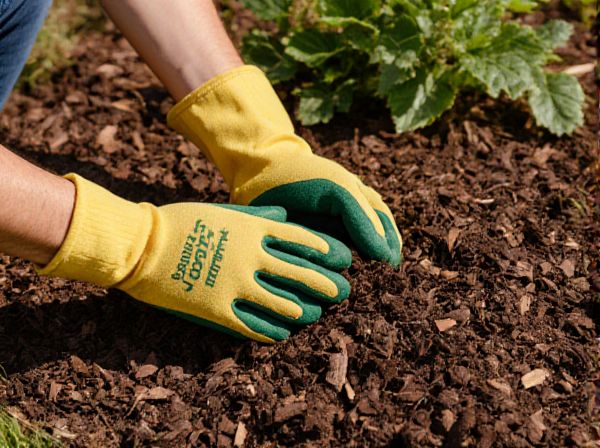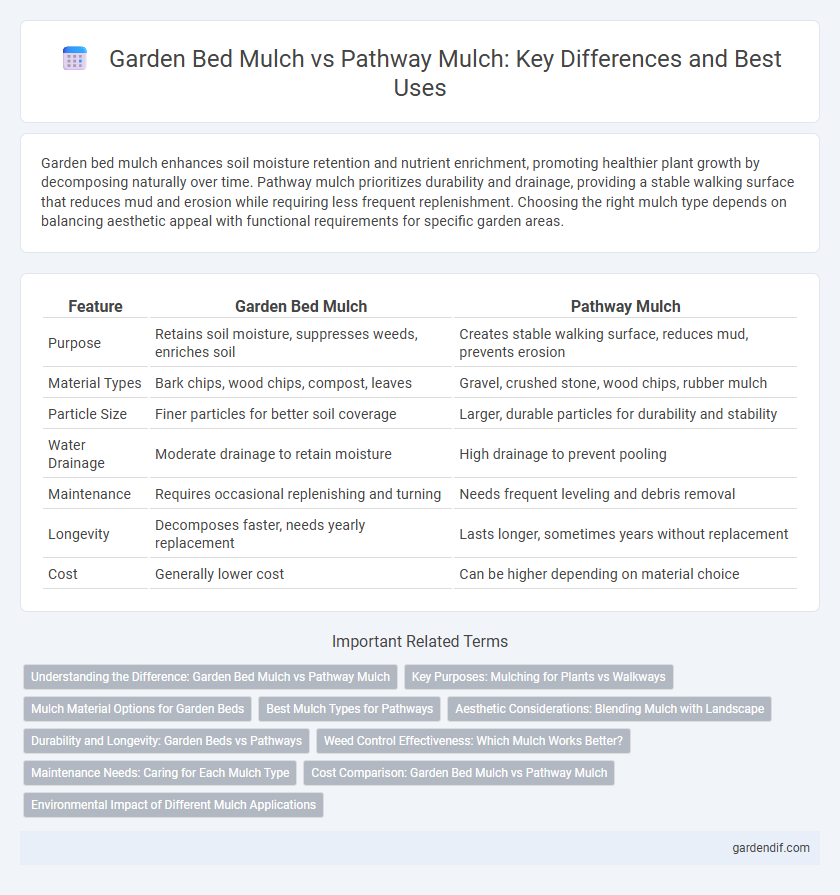
Garden Bed Mulch vs Pathway Mulch Illustration
Garden bed mulch enhances soil moisture retention and nutrient enrichment, promoting healthier plant growth by decomposing naturally over time. Pathway mulch prioritizes durability and drainage, providing a stable walking surface that reduces mud and erosion while requiring less frequent replenishment. Choosing the right mulch type depends on balancing aesthetic appeal with functional requirements for specific garden areas.
Table of Comparison
| Feature | Garden Bed Mulch | Pathway Mulch |
|---|---|---|
| Purpose | Retains soil moisture, suppresses weeds, enriches soil | Creates stable walking surface, reduces mud, prevents erosion |
| Material Types | Bark chips, wood chips, compost, leaves | Gravel, crushed stone, wood chips, rubber mulch |
| Particle Size | Finer particles for better soil coverage | Larger, durable particles for durability and stability |
| Water Drainage | Moderate drainage to retain moisture | High drainage to prevent pooling |
| Maintenance | Requires occasional replenishing and turning | Needs frequent leveling and debris removal |
| Longevity | Decomposes faster, needs yearly replacement | Lasts longer, sometimes years without replacement |
| Cost | Generally lower cost | Can be higher depending on material choice |
Understanding the Difference: Garden Bed Mulch vs Pathway Mulch
Garden bed mulch primarily improves soil fertility and moisture retention, using organic materials like bark, compost, or straw that decompose to enrich the soil. Pathway mulch focuses on durability and weed suppression, often made from inorganic options such as gravel, rubber, or coarse wood chips to withstand foot traffic. Understanding the functional differences helps select the right mulch type for healthy plants versus practical, low-maintenance walking areas.
Key Purposes: Mulching for Plants vs Walkways
Garden bed mulch primarily retains soil moisture, suppresses weeds, and regulates soil temperature to enhance plant health and growth. Pathway mulch, in contrast, provides a stable, non-slip surface that reduces soil erosion and minimizes mud in walkways. Selecting the right mulch type, such as shredded bark for beds and crushed stone or wood chips for pathways, optimizes the key purposes of soil protection versus foot traffic durability.
Mulch Material Options for Garden Beds
Garden bed mulch options prioritize organic materials such as shredded bark, composted leaves, and pine needles, which enhance soil fertility and moisture retention. These mulches slowly decompose, enriching the soil with essential nutrients, promoting healthy plant growth. In contrast, pathway mulch often uses more durable materials like gravel or rubber to withstand foot traffic and reduce compaction.
Best Mulch Types for Pathways
Gravel and crushed stone are ideal mulch types for pathways due to their durability, drainage capability, and low maintenance requirements. Hardwood mulch or shredded bark is more suited for garden beds as it enriches soil and retains moisture but can compact under foot traffic on paths. Rubber mulch offers long-lasting, slip-resistant coverage for pathways, making it a practical choice for high-traffic areas requiring consistent surface stability.
Aesthetic Considerations: Blending Mulch with Landscape
Garden bed mulch typically features finer textures and richer colors to seamlessly blend with plantings, enhancing vibrant flower beds and shrubbery. Pathway mulch often consists of coarser materials like shredded bark or gravel to create durable, visually distinct walkways that complement surrounding lawn areas. Selecting mulch based on color harmony and texture ensures cohesive landscape aesthetics, balancing functional needs and visual appeal.
Durability and Longevity: Garden Beds vs Pathways
Garden bed mulch typically consists of organic materials like bark, compost, or shredded leaves that decompose over time, enriching the soil but requiring regular replenishment every 1-2 years. Pathway mulch often uses more durable options such as crushed stone, gravel, or hardwood chips designed to withstand foot traffic and weather exposure, lasting 3-5 years or more without significant degradation. The choice between garden bed and pathway mulch impacts maintenance frequency and the overall lifespan of the mulch layer due to differences in material resilience and environmental stress.
Weed Control Effectiveness: Which Mulch Works Better?
Garden bed mulch typically outperforms pathway mulch in weed control effectiveness due to its denser application and organic composition, which suppresses seed germination more efficiently. Organic mulches like bark or wood chips in garden beds also improve soil moisture retention and nutrient content, further inhibiting weed growth. Pathway mulches, often lighter and less compact, allow more sunlight and air to penetrate, reducing their ability to prevent weeds compared to garden bed mulch.
Maintenance Needs: Caring for Each Mulch Type
Garden bed mulch typically requires more frequent replenishing and monitoring for moisture retention to support plant health, often benefiting from organic types like wood chips or bark that decompose and enrich soil. Pathway mulch demands durable, low-maintenance materials such as gravel or rubber mulch to prevent compaction and reduce weed growth while withstanding foot traffic. Both mulch types benefit from regular inspection to manage erosion, pests, and seasonal changes affecting their effectiveness.
Cost Comparison: Garden Bed Mulch vs Pathway Mulch
Garden bed mulch typically costs between $30 to $60 per cubic yard, depending on materials like shredded bark or composted leaves, while pathway mulch, often made from options such as pea gravel or wood chips, ranges from $20 to $50 per cubic yard. The higher cost of garden bed mulch reflects its finer textures and nutrient-rich properties vital for plant health, compared to the more durable, cost-effective materials used in pathways designed for foot traffic. Factoring installation and maintenance expenses, garden beds generally require more frequent replenishing, increasing long-term costs relative to pathway mulch.
Environmental Impact of Different Mulch Applications
Garden bed mulch primarily conserves soil moisture, suppresses weed growth, and enhances nutrient retention, promoting a healthier ecosystem with reduced water usage and minimized chemical inputs. In contrast, pathway mulch often requires frequent replenishment due to foot traffic compaction and erosion, potentially leading to increased resource consumption and carbon footprint. Choosing sustainable mulch materials like shredded bark or recycled wood chips can mitigate environmental impacts across both applications by supporting soil biodiversity and reducing waste.
Garden Bed Mulch vs Pathway Mulch Infographic

 gardendif.com
gardendif.com